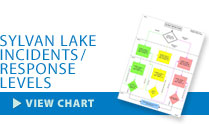Sylvan Lake EAP Case Study
DNR's Perspective

David Nance,
Engineering Geologist
David Nance, Engineering Geologist in the Project Development Section of the Division of Water was the Indiana DNR representative and liaison for the Sylvan Lake Dam IEAP team.
"DNR has had involvement with dam's construction and improvement for many years, and our data and insights needed to be transmitted to the IEAP team for inclusion in the document," said Nance, who attends most of the District's IEAP tabletop exercises. "This is a very good IEAP because it was developed by a company that has a lot of experience in IEAPs for the state. They know how to use the basic template and how to customize it to fit the desires and needs of local responding agencies.
"It's also a good IEAP because the Conservancy District did an outstanding job of very appropriately involving everyone who needed to be there. IEAPs need to be locally driven by the responding personnel and workable for them. It's something that can't be done by outsiders and handed to them. The on-site people need to be in control of the product because they are the ones who will have to administer it in an emergency. So they have to be at the forefront of development."
Nance said the IEAP is vitally important for the Sylvan Lake area because of dam's characteristics.
"Sylvan Lake Dam like any dam in Indiana is unique. For example, many Indiana dams have clay embankments. This dam is mostly sand. Most embankment dams were completely mechanically placed. This dam bridges between glacial mounts. That makes this dam different and adds to the complexity of the structure.
"Sylvan Lake Dam's characteristics don't add much complexity to the IEAP, but they make one kind of incident listed in the IEAP very important – seepage. There has to be a strong sensitivity to the fact that seepage is a critical issue with this structure. You can anticipate some seepage will occur, but you cannot allow a muddy discharge when the embankment is mostly sand. That can't be tolerated. Any seepage of that nature immediately shifts the situation to 'incident' status" and triggers the IEAP.
That recognition of the difference between a minor, expected occurrence (clear seepage) and a major concern (muddy discharge) – and the sense of urgency attendant to it – with the corresponding appropriate level of reporting and response may not have existed prior to creation of the IEAP.
With Sylvan Lake Dam one of the most important issues the IEAP team had to discuss with great attention and sensitivity was why and when and how much the Tainter gate may be opened to relieve pressure on the dam in extreme high-water situations, Nance said.
"Opening the Tainter gate is a very difficult decision, but allowing the dam to fail would be catastrophic," he said. "It's a good thing to talk it all out first so all participants in the IEAP process are heard and understand the ramifications. Opening that gate to relieve the pressure is how to save the dam in a severe emergency when the lake level has to be lowered in a controlled release. You can control the discharge to some degree with a Tainter gate, but at Sylvan Lake there is going to be flooding and damage if it's opened at all. The alternative is worse because all other forms of relieving the pressure are uncontrolled, and once that starts it can't be slowed or stopped."
The IEAP had to define this issue and criteria for decision making very carefully. Operating the Tainter gate requires two keys, and those upon whom it falls to turn them must know they are doing the right thing at the right time as specified in the IEAP and based on their own knowledge of the situation and the dam.
Another aspect of Sylvan Lake that Nance pointed out is the geology of its area in northern Indiana.
"Glacial trains have a more attenuated flow than other areas," he said. "In southern Indiana flows may be four or five times faster than what we see in the northern part of the state where there was glaciation. That means southern lakes can take a heavy rainfall load, quickly rise and then quickly lower the water level. But when Sylvan Lake takes in that same amount of water, it will have to hold it longer because the absorption and outflow take longer.
"The IEAP assures that everybody has talked through the anticipated events that could happen, put together the appropriate pattern of notifications and response depending on what is observed, and reported it in the correct format to people who need to know that it is occurring," said Nance. "Some occurrences do not require the same type of notification, some things happen slowly, some happen quickly. But by breaking down potential risks for various incidents that could occur, the potential threat to the overall stability of the dam can then determine what will be the appropriate response pattern and information exchange."
IEAPs can include templates of statements about problems at the dam to clearly state what is happening. Then people in response mode, having been to tabletop exercises, know what that means because the communication is clear and they understand exactly what is going on.
"This holds true for any dam and IEAP, and as we often say, 'Failing to plan is planning to fail,' but in the case of Sylvan Lake Dam they are planning to succeed."



